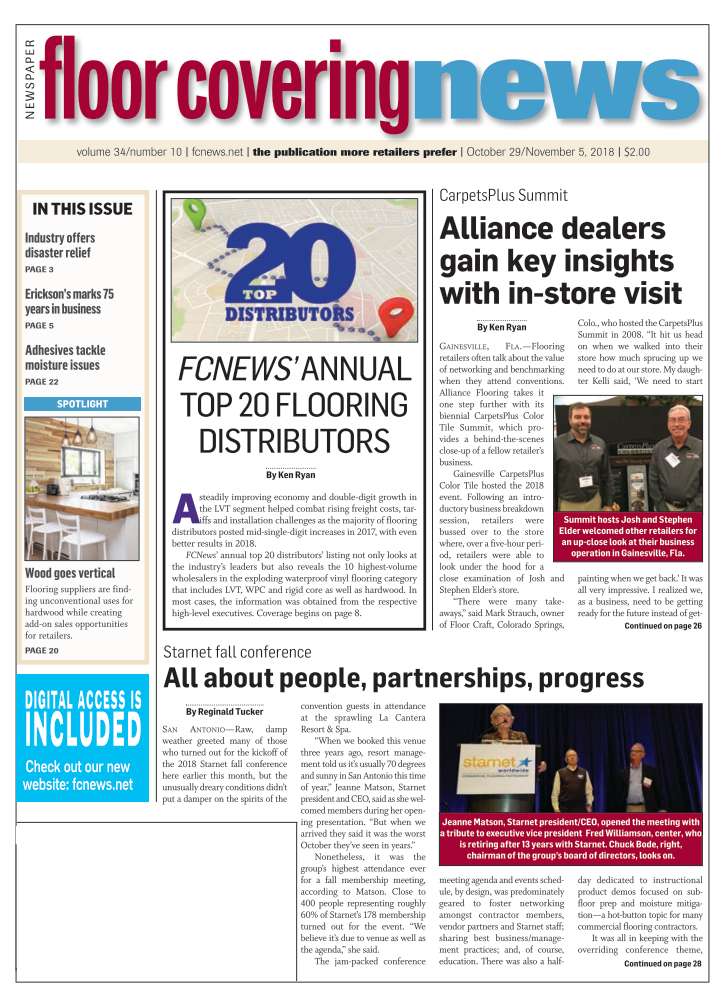October 29/November 5, 2018: Volume 34, Issue 10
By Graham Capobianco
 If you’re anything like me, the concept of installing a resilient floor tile or plank without adhesive likely made you scoff the first time you heard it. However, when installed correctly, loose-lay LVT can be a problem solver for many projects, especially in commercial environments.
If you’re anything like me, the concept of installing a resilient floor tile or plank without adhesive likely made you scoff the first time you heard it. However, when installed correctly, loose-lay LVT can be a problem solver for many projects, especially in commercial environments.
Loose-lay LVT has many of the same attributes of traditional glue-down or click-and-lock LVT. It has a durable wear layer that provides surface protection, a UV-cured finish that allows for ease of maintenance and a wide array of color and format options. What’s more, loose lay also has many other performance benefits that make it stand out when compared to traditional LVT.
Loose lay can be installed over existing floors. While there are some restrictions, this is easily the most useful attribute of loose-lay LVT. It’s especially useful for existing flooring materials that may be dangerous, difficult or costly to remove.
It can easily be removed and replaced. This makes loose-lay LVT ideal for temporary flooring installations, as removal and replacement will not damage the substrate or the flooring material.
Loose lay can be used over raised access floors. While there are also some restrictions here, loose-lay LVT can be installed directly over most raised access floors. Since loose lay can be removed and replaced whenever access is needed, it’s the ideal flooring for raised access floors.
It has a higher sound rating than traditional LVT. While traditional LVT typically doesn’t contribute to sound reduction, loose-lay LVT is a thicker product that offers improved sound testing results.
It can also butt up to thicker products. At approximately 5mm, most loose-lay LVT can butt up directly to a number of thicker products that would normally require a transition. Approximately 3⁄16-inch carpet, rubber and thin, hard surface products can usually be installed flush with the surface of loose-lay LVT with minimal preparation.
Though loose-lay LVT may be a problem solver, it is only as good as the substrate it’s installed over and the installation practices used to install it. With that being said, here are a few precautions that should be taken to ensure a successful installation.
Loose-lay LVT does require adhesive. Despite the name, loose-lay LVT typically does require adhesive in order to provide a tight installation. However, it requires significantly less adhesive than traditional LVT—typically, it only requires a band of adhesive around the perimeter of the installation. Loose-lay LVT installed with spray adhesive is also easier to remove and replace.
It requires a flat substrate. Just like glue-down or click-and-lock LVT products, loose lay requires a flat substrate prior to installation. While thicker than traditional LVT, loose-lay LVT will still telegraph divots, low/high spots, wide substrate voids and other substrate imperfections—this could also cause edge-lifting or gapping.
It also requires a solid substrate. Because loose-lay LVT is generally not glued to the substrate, it’s important that the substrate be fully adhered, solid, sound and supportive. Softer substrates may cause edge-lifting or gapping over time.
When done correctly, loose-lay LVT installations combine unique flexibility with an ideal visual aesthetic that meets the needs of many commercial flooring projects.

